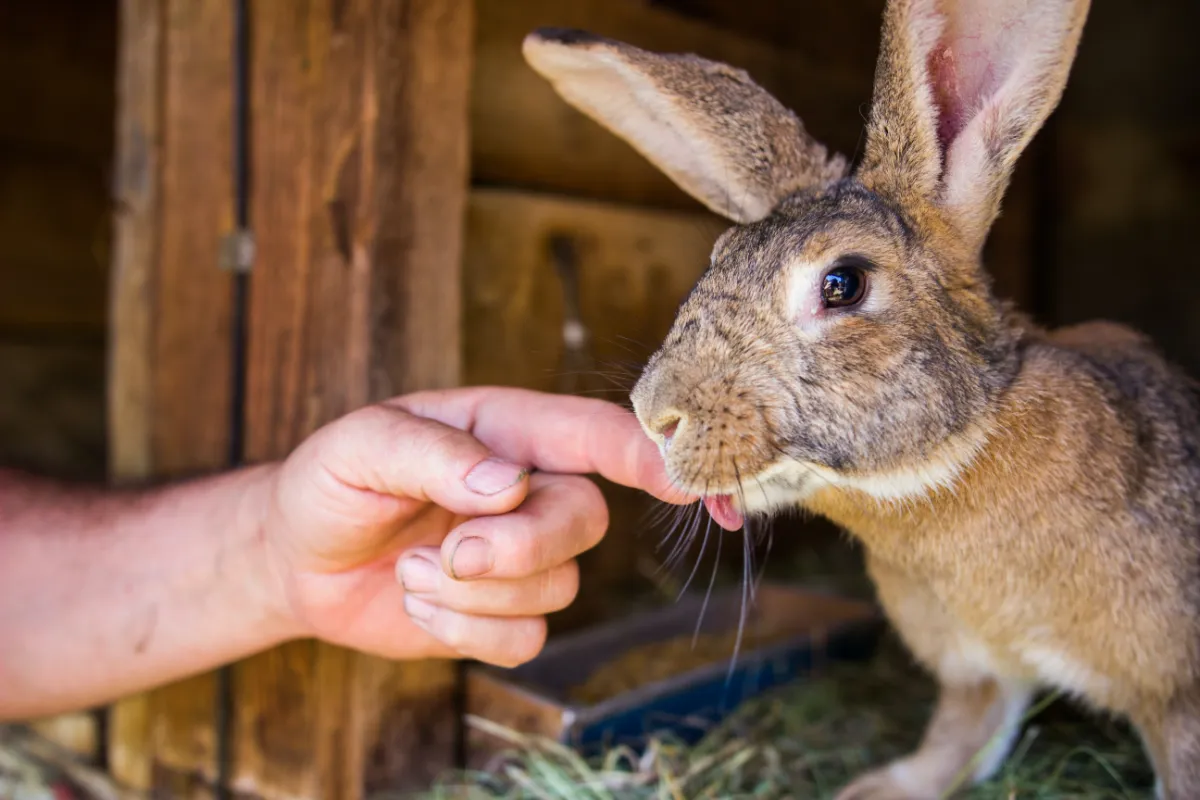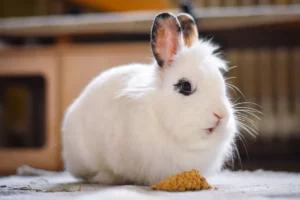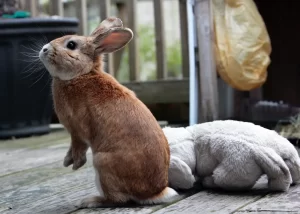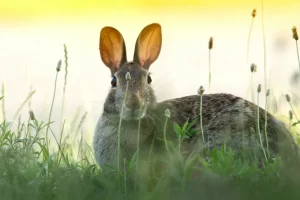If you’ve ever wondered what makes a rabbit’s fluffy tail twitch with joy, you’ve come to the right place. In this article, we’ll dive into the fascinating world of rabbit happiness.
Ever seen a rabbit do a happy little dance called a binky? Or noticed the subtle ways they show their contentment? Get ready to discover the secrets of a happy rabbit’s habits and how they communicate their joy.
Plus, we’ll share tips on creating the perfect environment for your furry friend to thrive. Let’s hop right in!
In This Article
- 1 Key Takeaways
- 2 Signs of Happiness in Rabbits
- 3 Binkies: The Joyful Leaps of a Happy Rabbit
- 4 Contentment: How Rabbits Show They’re Feeling Happy
- 5 Happy Rabbit Habits: Exploring Their Playful Behaviors
- 6 Communication: How Rabbits Express Happiness
- 7 Creating a Happy Environment for Your Rabbit
- 8 Frequently Asked Questions
- 8.1 How Long Do Rabbits Typically Stay Happy For?
- 8.2 Can Rabbits Experience Sadness or Depression?
- 8.3 Do Rabbits Show Their Happiness Differently During Different Seasons?
- 8.4 Can Rabbits Feel Happy if They Are Kept in Small Cages?
- 8.5 What Are Some Signs That Indicate a Rabbit Is Not Happy, Even if They Are Displaying Behaviors Associated With Happiness?
- 9 Conclusion
Key Takeaways
- Binkies are exuberant leaps and twists in the air, a common behavior displayed by happy rabbits.
- Nose bonks and relaxed flops indicate contentment and a deep sense of relaxation in rabbits.
- Playful behaviors such as zoomies and digging provide physical exercise and mental stimulation for rabbits.
- Observing a rabbit’s body language and providing a happy environment with toys and socialization are important for their happiness.
Signs of Happiness in Rabbits
You can easily identify signs of happiness in rabbits by observing their playful behavior. When rabbits are happy, they exhibit a range of behaviors that indicate their joy.
One of the most noticeable signs is their binkies, which are exuberant leaps and twists in the air. These binkies are a clear expression of their happiness and excitement.
Rabbits also engage in zoomies, where they run around in circles or dart back and forth with high energy. Another common behavior is called flopping, where they plop down on their side or back, completely relaxed.
Happy rabbits may also engage in playful digging, tossing toys around, or even performing little hops and jumps.
Binkies: The Joyful Leaps of a Happy Rabbit
Witness the sheer delight of a happy rabbit as it performs multiple binkies, leaping and twisting in the air with boundless joy.
These joyful hops, known as rabbit dances, are a common behavior displayed by rabbits when they’re feeling content and secure.
During these energetic displays, rabbits exhibit quick jumps, twists, and flicks of their hind legs, often accompanied by playful kicks and spins. This behavior is a way for rabbits to release their pent-up energy and express their happiness.
Rabbit dances can be seen in both domesticated and wild rabbits, and they serve as a form of communication among rabbits, signaling their positive emotional state.
Contentment: How Rabbits Show They’re Feeling Happy
Notice how rabbits demonstrate their happiness through various behaviors, such as gentle nose bonks and relaxed flops. Understanding rabbit body language is crucial for bonding with your rabbit and ensuring their well-being.
Here are some key behaviors that indicate your bunny is feeling content:
- Nose bonks: When your rabbit gently bumps their nose against you, it shows trust and affection. This is their way of bonding with you and acknowledging your presence.
- Relaxed flops: Rabbits will often flop onto their sides or backs when they feel safe and comfortable. This vulnerable position signifies a deep sense of relaxation and contentment.
It’s important to respond to these behaviors in a positive way to strengthen your bond with your rabbit. Gently petting them or offering a treat can reinforce their happiness and trust in you. By understanding and responding to their body language, you can create a loving and fulfilling relationship with your furry friend.
Happy Rabbit Habits: Exploring Their Playful Behaviors
Explore the many playful behaviors that happy rabbits exhibit, from energetic binkies to joyful zoomies.
Rabbits are social animals that thrive on playtime activities. Engaging in play not only provides physical exercise but also promotes mental stimulation and emotional well-being.
During play, rabbits often engage in binkies, where they leap into the air and twist their bodies in mid-air, expressing sheer joy. Zoomies, on the other hand, involve rapid running and darting around in excitement.
These playful behaviors not only serve as a way for rabbits to release pent-up energy but also strengthen their muscles and improve coordination. Additionally, playtime activities can enhance the bond between rabbits and their human companions.
By participating in interactive play, such as using toys or engaging in gentle chasing, rabbits develop trust and affection towards their caregivers.
Communication: How Rabbits Express Happiness
Do you ever catch your rabbit doing binkies and zoomies, expressing their happiness through playful leaps and rapid running? Rabbits have unique ways of communicating their emotions, and when they’re happy, they often display a range of nonverbal cues.
Here’s what you need to know:
- Body Language:
- Binkies: These are joyful leaps and twists in the air, indicating pure happiness.
- Zoomies: Rapid running and darting around is a sign of excitement and contentment.
- Social Interaction:
- Flopping: When a rabbit flops onto their side or back, it signifies relaxation and trust in their environment.
- Nose Bonks: Rabbits show affection by gently touching noses, strengthening social bonds.
Understanding these nonverbal cues is essential for building a strong bond with your furry friend. By observing their behavior, you can ensure that your rabbit is happy and well-cared for in their environment.
Creating a Happy Environment for Your Rabbit
If you want your rabbit to be happy, make sure to provide them with plenty of toys and a comfortable living space. Toys play a crucial role in the overall well-being of rabbits, keeping them mentally stimulated and physically active. There are various types of toys that you can offer your rabbit, such as chew toys, tunnels, and puzzle toys.
These toys not only provide entertainment but also fulfill their natural instinct to explore and forage. Additionally, socialization is key to a rabbit’s happiness. Rabbits are social animals and thrive on companionship.
Consider getting a companion for your rabbit or spending quality time with them to ensure they receive adequate social interaction. A happy rabbit is a healthy rabbit, so make sure to create a stimulating and social environment for your furry friend.
| Benefits of Toys for Rabbits | Benefits of Socialization |
|---|---|
| Mental stimulation | Reduced loneliness |
| Physical exercise | Improved behavior |
| Natural instinct fulfillment | Enhanced emotional well-being |
Frequently Asked Questions
How Long Do Rabbits Typically Stay Happy For?
Rabbits typically stay happy for varying durations. They communicate their happiness through behaviors like binkying and purring. Different rabbits may have different levels of happiness, influenced by factors such as environment and social interactions.
Can Rabbits Experience Sadness or Depression?
Rabbits can experience sadness or depression, just like humans. They may feel lonely or isolated without social interaction. To ensure their happiness, it’s important to provide them with companionship and a stimulating environment.
Do Rabbits Show Their Happiness Differently During Different Seasons?
Rabbits exhibit different behaviors when they are happy during different seasons. Their happiness manifests differently in winter compared to summer. Understanding these variations can help you provide the best care for your rabbit throughout the year.
Can Rabbits Feel Happy if They Are Kept in Small Cages?
Rabbits can still feel happiness in small cages, but their well-being may be affected. Providing alternative housing options, such as larger enclosures or supervised free-range time, can greatly improve their overall happiness and welfare.
What Are Some Signs That Indicate a Rabbit Is Not Happy, Even if They Are Displaying Behaviors Associated With Happiness?
If a rabbit is displaying behaviors associated with happiness, but you suspect they may not actually be happy, look for signs of unhappiness such as decreased appetite, aggression, or excessive grooming. The impact of their environment can greatly affect their happiness.
Conclusion
In conclusion, when rabbits are happy, they exhibit various behaviors to express their joy. Binkies, those delightful leaps of happiness, are one common sign to look out for.
Additionally, contentment can be observed through relaxed body language and a calm demeanor. Rabbits also engage in playful behaviors, such as exploring and hopping around, when they’re feeling happy.
Effective communication, through body language and vocalizations, is another way rabbits express their happiness. By creating a happy environment, you can ensure your rabbit’s well-being and overall happiness.
So, hop to it and make your furry friend’s tail wag with delight!





